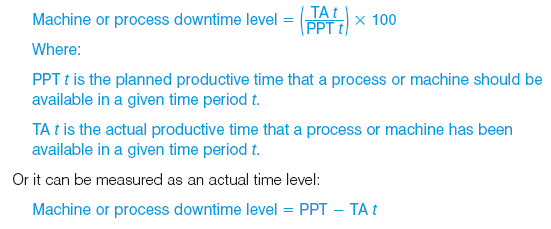Process or machine downtime level
Strategic perspective
Operational processes and supply chain perspective
Key performance question this indicator helps to answer
To what extent are we operating our processes or machines effectively?
Why is this indicator important?
Any business wants to minimise non-productive time. If machines or processes are not available when they are needed, this reduces the output that can be generated and therefore reduces profits and margins for the business.
Downtime is any productive time in which a machine or process is not available due to circumstances such as faults or maintenance.
While machine downtime is traditionally associated with the manufacturing industry, process downtime is relevant to any industry. Take, for example, call centres that need to track the downtime of their help-desk processes or hospitals that want to monitor the non-availability of diagnostic equipment.
Understanding the level of downtime provides companies with an insight into how effective their internal operational processes are (be it equipment- or process-based).
How do I measure it?
Data collection method
Data for machine or process downtime will come either directly from the machine or process or from records.
Formula
Machine or process downtime level can be measured as a ratio:

Frequency
Machine or process downtime is a measure that can, especially if monitoring is automated, be measured continuously and reported as an indicator if the downtime reaches a predefined threshold. Alternatively, monthly or quarterly reporting might be sufficient.
Source of the data
Data can be taken from the machine itself, as many machines track their own downtime automatically. If automated process monitoring is in place then the same applies to processes. In some cases manual record keeping might be required.
Cost/effort in collecting the data
Costs for measuring process or machine downtime are moderate, depending on the level of data already available. If machines and processes are automatically generating downtime data, the calculations are relatively simple. If manual record keeping is required, this will push up costs.
Target setting/benchmarks
The target for downtime level should be zero, with the aim of eliminating or at least minimising any unplanned interruptions to the production process – especially if a process or machine is not used around the clock and maintenance can be scheduled for non-productive times.
Example
Let’s look at a radiography department in a hospital, for example. The department has two CT (computed tomography) scanners for which it wants to measure downtime. The aim is to have at least one available 24 hours a day but both available during ‘routine business hours’ (between 9am and 5pm = 8 hours).
The hospital is measuring downtime as any time that one of the scanners is not available during routine business hours and critical downtime as any time when both CT scanners are not available.
Here is an example of a 24-hour time-frame:
CT scanner 1 was not available between 1pm and 3pm because of a fault and between 7pm and 10pm it was undergoing maintenance.
CT scanner 2 was not available between 7pm and 8pm because of a fault.
![]()
Downtime level for CT scanner 2 = 0%
![]()
Tips/warnings
When measuring machine downtime level it is useful to understand the cost implications, such as the direct labour costs that you are losing because the machine is not available but you still have to pay the costs for the people who are there to operate the machine.
